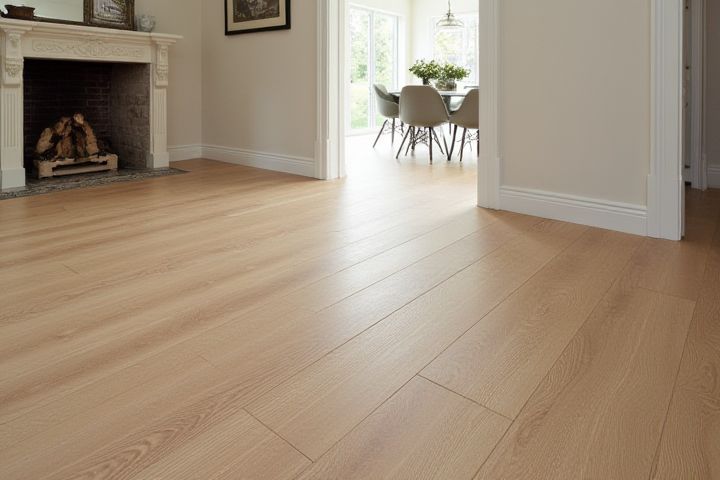
Choosing house flooring involves evaluating several crucial factors to ensure you make the right decision for your space. Start by considering the room's purpose; for instance, moisture-resistant flooring like vinyl or tile is ideal for bathrooms and kitchens, while hardwood or carpet might be better suited for living areas. Assess the durability and maintenance requirements, especially if you have pets or children, where scratch-resistant options could be beneficial. Your budget will also significantly influence your choice; laminate and vinyl are typically more affordable without sacrificing aesthetic appeal. Lastly, take into account the overall design style of your home, ensuring the flooring complements your decor and enhances the ambiance of your living environment.
How To Choose House Flooring
Budget planning
When selecting house flooring, start by determining your budget, which will narrow down your options significantly. Consider materials such as laminate or vinyl for cost-effective solutions that still offer durability and style. If you're aiming for a more upscale look, engineered hardwood or luxury vinyl tiles can provide a balance between aesthetics and cost. Remember to account for installation expenses and maintenance, ensuring that your flooring choice aligns with your overall financial plan.
Room usage
When selecting house flooring, consider the specific usage of each room to ensure durability and comfort. For high-traffic areas like hallways and living rooms, opt for hard surfaces such as laminate, vinyl, or tile, which can withstand wear and tear while being easy to clean. In contrast, bedrooms and home offices benefit from softer materials like carpet or engineered wood that provide warmth and sound insulation. By aligning your flooring choice with the activities performed in each space, you enhance both functionality and aesthetic appeal.
Durability
When selecting house flooring, prioritize materials known for their durability, such as tile, hardwood, or vinyl. Tiles, particularly porcelain, offer exceptional resistance to scratches and moisture, making them ideal for high-traffic areas like kitchens and bathrooms. Hardwood flooring, specifically engineered hardwood, can withstand wear and tear while adding elegance to your space, with an average lifespan of 20 to 30 years. Vinyl flooring, on the other hand, is a cost-effective option that can last up to 20 years, and it's often available in designs resembling wood or stone for aesthetic appeal.
Maintenance needs
When selecting house flooring, consider materials that match your maintenance preferences. Hardwood floors require periodic refinishing and regular cleaning, while laminate and vinyl offer increased durability and are easier to maintain. If you have pets or children, choosing options like tile or luxury vinyl plank can provide resistance to scratches and stains. You should also evaluate the cleaning products and frequency required for each type to ensure it aligns with your lifestyle and maintenance capabilities.
Aesthetic appeal
When selecting house flooring, prioritize the visual impact that different materials and styles can offer. Hardwood floors exude warmth and elegance, creating a classic aesthetic that complements various interior designs. For a modern look, consider porcelain tiles, which can mimic natural stone or wood while providing durability and easy maintenance. You should also evaluate color schemes and textures to ensure the flooring harmonizes with your existing furnishings and enhances the overall ambiance of your space.
Climate suitability
Consider hardwood flooring if you live in a temperate climate, as it adapts well to seasonal changes, providing warmth in winter and a cool feel in summer. In humid regions, tile or vinyl sheets are ideal due to their resistance to moisture and mold growth. For colder climates, carpet can add insulation, reducing heating costs by up to 10%. Any flooring material should also be evaluated for its energy efficiency, contributing to your home's overall sustainability.
Installation process
When selecting house flooring, consider the installation process as a crucial factor. Different materials, such as hardwood, laminate, vinyl, and tile, have varying installation methods that can affect both cost and time. For example, hardwood and tile often require professional installation due to their complexity, while laminate and vinyl may offer DIY-friendly options for easy handling. Understanding the specific requirements, such as subfloor preparation and adhesive needs, will help you make an informed choice that aligns with your skill level and budget.
Safety and comfort
When selecting house flooring, prioritize materials that enhance safety, such as slip-resistant tiles for wet areas and soft carpets that cushion falls. For comfort, consider options like engineered wood or luxury vinyl, which provide warmth underfoot while being durable and easy to maintain. The American Society for Testing and Materials (ASTM) recommends a minimum coefficient of friction of 0.6 for safe flooring surfaces. Ensure your choice is suitable for your home's specific needs, factoring in lifestyle preferences and potential allergens.
Environmental impact
Consider flooring options that utilize sustainable materials, such as bamboo, cork, or reclaimed wood, which minimize deforestation and reduce carbon footprints. Look for products certified by organizations like the Forest Stewardship Council (FSC) or those that meet strict environmental standards. Opt for low-VOC (volatile organic compounds) flooring to enhance indoor air quality and reduce harmful emissions. Your choice can significantly impact the environment, so prioritize energy-efficient choices and long-lasting materials to promote sustainability in your home.
Resale value impact
When selecting house flooring, consider materials that enhance resale value, such as hardwood, which can boost home worth by up to 2.5%. Porcelain tiles are also a popular choice, offering durability and aesthetics, which potential buyers often seek. Your choice of flooring can significantly influence buyer perception, with modern and appealing designs likely to attract more interest. Prioritize neutral colors and timeless styles to maintain broad appeal in a competitive market.
